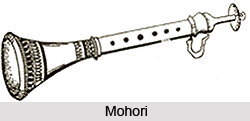 The Mohori is a wind instrument used in India. It is a kind of tribal and folk oboe also known as the Mori. According to various musicians, this musical instrument is perhaps linguistically related to mari meaning a tube or drain.
The Mohori is a wind instrument used in India. It is a kind of tribal and folk oboe also known as the Mori. According to various musicians, this musical instrument is perhaps linguistically related to mari meaning a tube or drain.
History of Mohori
The use of this wind instrument can be traced back a long way, almost to the 6th century AD. The word `Mohori` seems to be related to Mahudi and Magudi, the snake -charmer"s single-reed pipe of south India. This in turn has been Sanskritised to Madhukari and Madhukali. The earliest reference to this instrument is in Matanga`s Brihaddesi as Mavari and Madvari (sixth-ninth century AD). Other works in which this instrument is mentioned are by Nanya (eleventh century), Sarangadeva (thirteenth century), Verna (fourteenth century) and Chikkabhoopala (seventeenth century). The Kannada poets, Raghavanaka (thirteenth century) in his Harishchandra Kavya, Singiraja (fifteenth century) in Singiraja Puranam and Govinda Vaidya (seventeenth century) in his Kantheerava Narasaraja Vijaya, give it as Mouri; but the Kannada poet-saint-musician, Purandara Dasa, also used the term Mourya in his Suladis (which were long compositional types, each section having a different Tala).
Designs of Mohori
Mohori known in many areas, as a folk instrument, is somewhat similar to the Shehnai. But the Mohori found in Assam is very different. It is made of bamboo, in three sections which are detachable, the middle one having six holes. The Khasis of Assam have the Katangmuri; the Muri in this word is also significant.




















